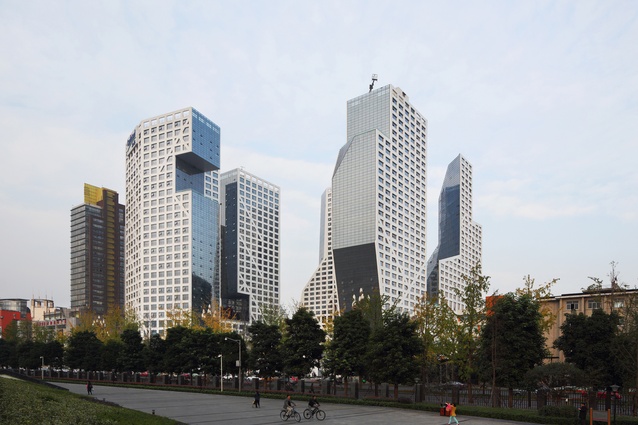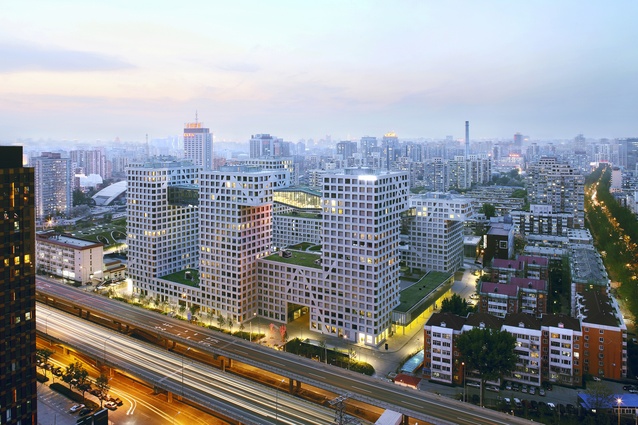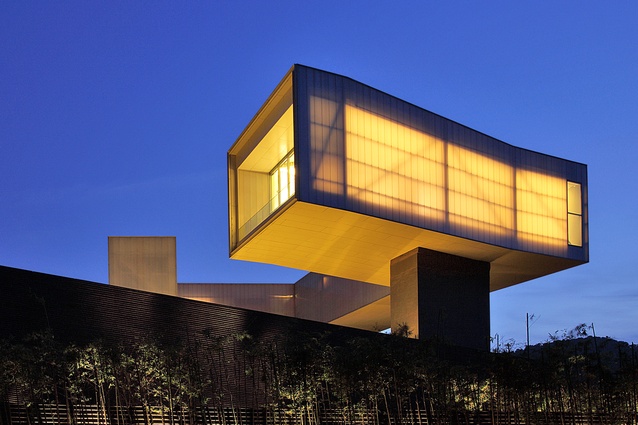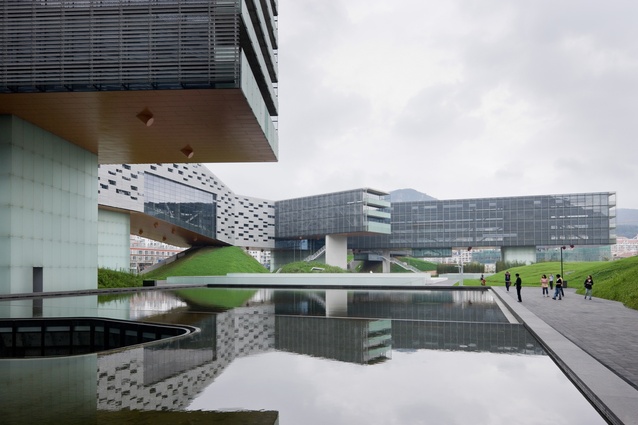Epic scale: Roberto Bannura
The 310,000m² Sliced Porosity Block in Chengdu, the 120,000m² Horizontal Skyscraper in Shenzhen and the 220,000m² Linked Hybrid complex in Beijing are some of the epic-scale projects in China which architect Roberto Bannura has worked on.
Justine Harvey interviewed the Chilean-born architect, a director at Steven Holl Architects’ based in Beijing, during his lecture series in New Zealand earlier this year.
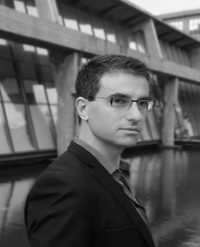
Justine Harvey: You’ve worked in diverse spots across the globe, such as Chile, New York and China. What were your experiences working in these very different places?
Roberto Bannura: Well, it’s been a very educational trip for me. I arrived in the United States with no intention of staying there but I actually ended up staying for 10 years. When it comes to my professional development and the things I saw in architecture there, it’s like working at a totally different level.
As in other major cities, there is ambition and excellence in the type of work being produced; there is talent capital that is attracted to the industry itself and excellence in terms of materiality, detailing, construction methods, contracting, etc. It is much more advanced in the United States as opposed to Chile. I feel as if I received a second education in architecture there and the principles I learnt in the United States are ones that our office continues to work with in China.
In many ways, China has modelled the way they undertake projects or write codes from the United States, so it is not too dissimilar to come in and try to work within the same structure. In China, we face different challenges, such as not having full certainty of the programme, of the project itself or even of a schedule. In China, you learn how to be flexible about the challenges that arise and you learn how to improvise.
JH: Is the process more prescriptive in the States?
RB: Yes, the process is scripted but the outcome is still up to you in a way. China is the opposite, you must exercise a lot of flexibility. You have to try to guess what is ahead of you and not believe that just because it’s drawn a certain way it will get built like that, or that it will be purchased in the bidding process in that way. Even if the client accepts something, they might refuse to do it later or change the parameters with very little notice. You have to establish very close relationships with people that you work with and try to investigate what is going to come up later.
JH: It sounds like a fair amount of crystal ball gazing goes on.
RB: You really have to try and help each other go through the process. There is a perception that all the information that is normally shared with the architect in the United States or Europe is not normally shared in China.
JH: In what way?
RB: You never fully know the budget of the project. You work within certain specific parameters of budget but, in China, you cannot go back and offer certain savings in some areas or try to work with the clients to shift budgets from one object to another to give you more flexibility. There’s no overall understanding of the budget and there’s very little we can do about that. Client relationships are normally more transparent in the United States than in China.
JH: Do you think that’s partly a cultural thing or is it more about the process?
RB: I think it’s more about the high degree of competition that all these developments have and, also, about safeguarding the client’s information. It’s a very aggressive market in that sense. I don’t think it’s a cultural thing as such.
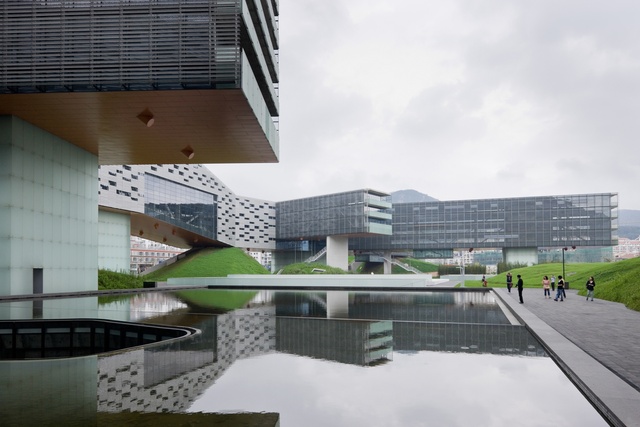
JH: The scale of the projects in China, which Steven Holl Architects is working on, is epic, especially in comparison with New Zealand or Chile, even. Did that take a lot of adjustment after working on such a diverse range of smaller projects beforehand? Even after coming from New York, where you also have very large developments, it’s a different thinking process isn’t it?
RB: There was definitely an adjustment because the projects were much more complex and much bigger, but the process of design, the problems that you face and the compromises that you work through are pretty much across the board. I think that, if you’re a seasoned architect, you can manage the rest of it. Obviously, there are some challenges which are more specific from one topology to another but the scale, the speed and the schedule are variables that you work with throughout the process.
JH: I think it can be hard for people in New Zealand to get their heads around that immense scale of building. How do you retain the soul of a place when you’re dealing with that kind of scale which is really the antithesis of the human scale?
RB: Practising on these mega malls makes it very interesting and, by doing so, we’re developing a new type of approach to this project typology and I think that’s where we’re most interested. The thought process and exploring new things, applying the principles of site and programme in different conditions is an exploration; it’s never a repetition. You can find the same level of challenges in a small project as in a large project but you have to adjust yourself to thinking differently and to give priority to where the requirements are needed regarding schedule and scale, the dimension of the public space, etc. A small house will have a totally different set of concerns. Your costs are the same but your emphasis is probably more on materiality and things like that. Overall, they’re not too dissimilar in terms of the process or execution.
JH: What is it like to live in that sort of scale of development? I guess, if you live there, it’s normal but, as an outsider, it seems strange.
RB: It is a bit of a challenge at the beginning but it is very interesting at a personal level. For my wife and I, we were very intrigued with how people live and how life is experienced in these developments, such as having to travel 40 minutes from one side of the city to another to watch a movie, especially after living for 10 years in Manhattan, New York, where you can take a subway ride of 15 minutes and you’re pretty much anywhere. Over time [that travelling] becomes a bit of a burden and, then, you realise it’s something that you have to cope with. You try to restrict your movements as much as you can – but that’s Beijing.
Hong Kong is the opposite, it has a high degree of density and everything is happening in the same time and the same place, and there’s different layers of vertical stacking. It’s more like a vertical New York or something similar to that, and that produces a different type of living – a larger urban centre. Shanghai is a totally different thing and Beijing has its positives: it is super safe, it is very cosmopolitan and we live in a very nice compound, they have really beautiful grounds and we are pretty much there in the weekends. That’s a very positive aspect of Beijing but, if you want to go outside of that, you have to travel and that’s a negative. So it’s a highly diverse place.
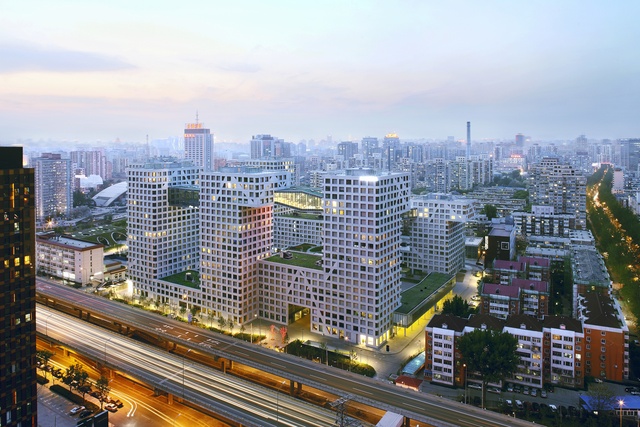
JH: Do you think that the thinking process is changing? In Auckland, which has a fairly small population for a large land area, we still build on the outskirts of the city without amenities and public transport nearby and, having personally worked for architects who promote building denser mixed-use communities, it seems to me that this thinking is quite slow, to be honest. Although it seems to depend on who’s designing and building it. So, I’m interested in what’s happening in China where there is a huge migration from rural areas to the cities.
RB: Chinese cities are going through a densification process for sure. But it depends on the city as to the response you will see. Take Beijing, for example, where it’s happening in both environments: the city centre is becoming densified but it’s also sprawling at the same time. If the development of a housing compound, for example, is left exclusively to the developer, then it will maximise the area and make the landscaping inclusive for the development and exclusive for anyone else to come in. It will be very private if you leave it to them, so that’s a challenge.
In Manhattan, there are some incentives for the developer to provide cultural facilities in exchange for certain additional areas; providing plazas for additional building height, for example. This works really well in an urban centre because it’s somewhat diversified and you can have easy access to these places through decent transportation.
Unfortunately, in Beijing’s large developments, there are many galleries that are very difficult to access because they’re so far away and difficult to get to, so it doesn’t quite work very well. I think that one of the best examples to combat this is – and I’m sorry to be self-referential – is what we did with the Linked Hybrid complex, which has a public movie theatre in the central plaza and it’s close to the subway station so it’s within the city grid. It’s successful and functional but so many developments aren’t like that.
JH: I guess you would hope that this type of precedent will help to change mindsets.
I wonder, having seen migration from rural to urban areas in New Zealand and now seeing the decimation of communities, do you think we should slow down this trend? Thinking about the vibrant towns of my youth which are now skeleton towns. There is a political approach that needs addressing, I think, in terms of supporting regional areas and helping those to thrive in order to create a more comfortable level of urbanisation in the cities too. Do you have any thoughts about that, because the process must be so much more intense in China?
RB: And much faster too. I’ve read a lot about it, discussed it at universities, heard a lot of different points of view and thought about it but I haven’t formed an opinion to be honest. It’s hard to make up your mind because it’s such a complex situation. In China, 250 million people have moved to the cities, which isn’t new – the government has been doing it for many years but it has just recently caught the attention of the world.
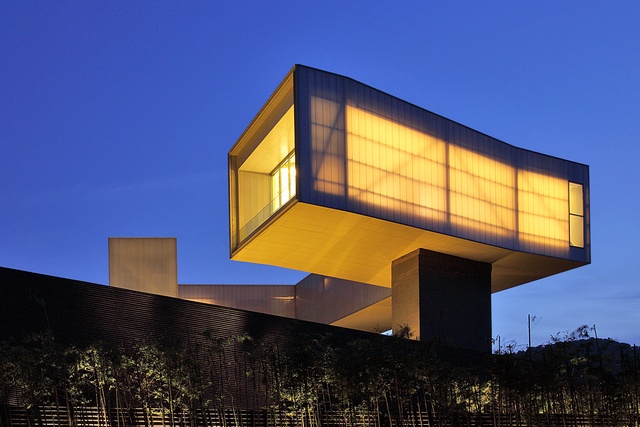
JH: And there must be a lot of positives in that as well.
RB: It makes sense that you would want to bring a lot of people closer to services. In New York, people complain about the subway system but it runs 24 hours a day and moves over four million people. I receive that response from professors or writers in China who are supporters of this cause and say, “That may be an issue in the Western countries but, for us, it’s a means of functioning, of supporting a country that has 1.3 billion people and a mostly rural population without services.”
Fine, this works: moving 250 million people to urban centres works. There is also the issues of demands on services and creating economies and all of that stuff. So, in that degree, I think that it’s like complaining about the subway system in New York… it’s still working. In their minds, it’s a measure that needs to be taken so it has to work so the people can have better lifestyles.
The flipside of that is that it’s all based on subsidies and usually farmers or people who are not accustomed to living in an urban setting, they are given an apartment and living expenses, but who knows what happens to that social situation. So I’ve heard both sides of the story in many different ways and it’s a very complex issue.
JH: You’ve also talked about the integration of landscape into your projects, which is interesting, particularly on large-scale projects, because so often landscapes are included later in the design process. Is there a deliberate strategy to bring landscapes into your projects?
RB: How the project will integrate or not integrate, or interact, with the landscape is always included in Steven’s original schedules very early on. From the very start we look at how we’re going to situate the project and investigate the relationships between the spaces of the building and the size of the outside grounds.
JH: From the way you’ve talked about him in your lectures, it sounds like Steven Holl is intrinsically involved in the concept of every project.
RB: We’re not a large company and we’re not taking on many projects for that reason, so he’s involved in everything at every stage of the design process. He particularly makes decisions around the level of quality, not so much the quality of the built project but the quality of the ideas, the design, the concepts and the experimentation. The concepts take a lot of time and effort and we don’t want to have too many of those things running at the same time. It’s fun.
Roberto Bannura’s lecture tour in New Zealand was supported by the NZIA Waikato/Bay of Plenty Branch.

